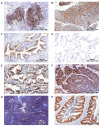The Role of SATB1 in Tumour Progression and Metastasis
- PMID: 31450715
- PMCID: PMC6747166
- DOI: 10.3390/ijms20174156
The Role of SATB1 in Tumour Progression and Metastasis
Abstract
Carcinogenesis is a long-drawn, multistep process, in which metastatic spread is an unequivocal hallmark of a poor prognosis. The progression and dissemination of epithelial cancers is commonly thought to rely on the epidermal-mesenchymal transition (EMT) process. During EMT, epithelial cells lose their junctions and apical-basal polarity, and they acquire a mesenchymal phenotype with its migratory and invasive capabilities. One of the proteins involved in cancer progression and EMT may be SATB1 (Special AT-Rich Binding Protein 1)-a chromatin organiser and a global transcriptional regulator. SATB1 organizes chromatin into spatial loops, providing a "docking site" necessary for the binding of further transcription factors and chromatin modifying enzymes. SATB1 has the ability to regulate whole sets of genes, even those located on distant chromosomes. SATB1 was found to be overexpressed in numerous malignancies, including lymphomas, breast, colorectal, prostate, liver, bladder and ovarian cancers. In the solid tumours, an elevated SATB1 level was observed to be associated with an aggressive phenotype, presence of lymph node, distant metastases, and a poor prognosis. In this review, we briefly describe the prognostic significance of SATB1 expression in most common human cancers, and analyse its impact on EMT and metastasis.
Keywords: EMT; SATB1; Special AT-Rich Binding Protein 1; cancer; epidermal-mesenchymal transition; metastasis.
Conflict of interest statement
The authors declare no conflict of interest.
Figures


Similar articles
-
Functional relevance of SATB1 in immune regulation and tumorigenesis.Biomed Pharmacother. 2018 Aug;104:87-93. doi: 10.1016/j.biopha.2018.05.045. Epub 2018 May 14. Biomed Pharmacother. 2018. PMID: 29772444 Review.
-
SATB1 reprogrammes gene expression to promote breast tumour growth and metastasis.Nature. 2008 Mar 13;452(7184):187-93. doi: 10.1038/nature06781. Nature. 2008. PMID: 18337816
-
SATB1 overexpression regulates the development and progression in bladder cancer through EMT.PLoS One. 2015 Feb 23;10(2):e0117518. doi: 10.1371/journal.pone.0117518. eCollection 2015. PLoS One. 2015. Retraction in: PLoS One. 2024 Apr 2;19(4):e0301572. doi: 10.1371/journal.pone.0301572. PMID: 25706386 Free PMC article. Retracted.
-
The Special AT-rich Sequence Binding Protein 1 (SATB1) and its role in solid tumors.Cancer Lett. 2018 Mar 28;417:96-111. doi: 10.1016/j.canlet.2017.12.031. Epub 2018 Jan 4. Cancer Lett. 2018. PMID: 29306014 Review.
-
SATB1 protein is associated with the epithelial‑mesenchymal transition process in non‑small cell lung cancers.Oncol Rep. 2021 Jun;45(6):118. doi: 10.3892/or.2021.8069. Epub 2021 May 6. Oncol Rep. 2021. PMID: 33955522 Free PMC article.
Cited by
-
Computed tomography-based nomogram of Siewert type II/III adenocarcinoma of esophagogastric junction to predict response to docetaxel, oxaliplatin and S-1.World J Radiol. 2024 Jan 28;16(1):9-19. doi: 10.4329/wjr.v16.i1.9. World J Radiol. 2024. PMID: 38312347 Free PMC article.
-
Triptolide inhibits esophageal squamous cell carcinoma progression by regulating the circNOX4/miR-153-3p/SATB1 signaling pathway.Thorac Cancer. 2024 Mar;15(7):538-549. doi: 10.1111/1759-7714.15215. Epub 2024 Jan 24. Thorac Cancer. 2024. PMID: 38268309 Free PMC article.
-
MicroRNA-409 regulates the proliferation and invasion of breast cancer cell lines by targeting special AT-rich sequence-binding protein 1 (SATB1).Bioengineered. 2022 May;13(5):13045-13054. doi: 10.1080/21655979.2022.2073320. Bioengineered. 2022. PMID: 35611599 Free PMC article.
-
Unlocking Dendritic Cell-Based Vaccine Efficacy through Genetic Modulation-How Soon Is Now?Genes (Basel). 2023 Nov 23;14(12):2118. doi: 10.3390/genes14122118. Genes (Basel). 2023. PMID: 38136940 Free PMC article. Review.
-
Progress in Delivery of siRNA-Based Therapeutics Employing Nano-Vehicles for Treatment of Prostate Cancer.Bioengineering (Basel). 2020 Aug 10;7(3):91. doi: 10.3390/bioengineering7030091. Bioengineering (Basel). 2020. PMID: 32784981 Free PMC article. Review.
References
-
- Ritchie H., Roser M. Causes of Death. [(accessed on 13 July 2018)]; Available online: https://ourworldindata.org/causes-of-death.
-
- American Institute of Cancer Research Cancer Trends Comparing More and Less Developed Countries. [(accessed on 13 July 2018)]; Available online: https://www.wcrf.org/int/cancer-trends/comparing-more-less-developed-cou....
Publication types
MeSH terms
Substances
LinkOut - more resources
Full Text Sources
Research Materials

